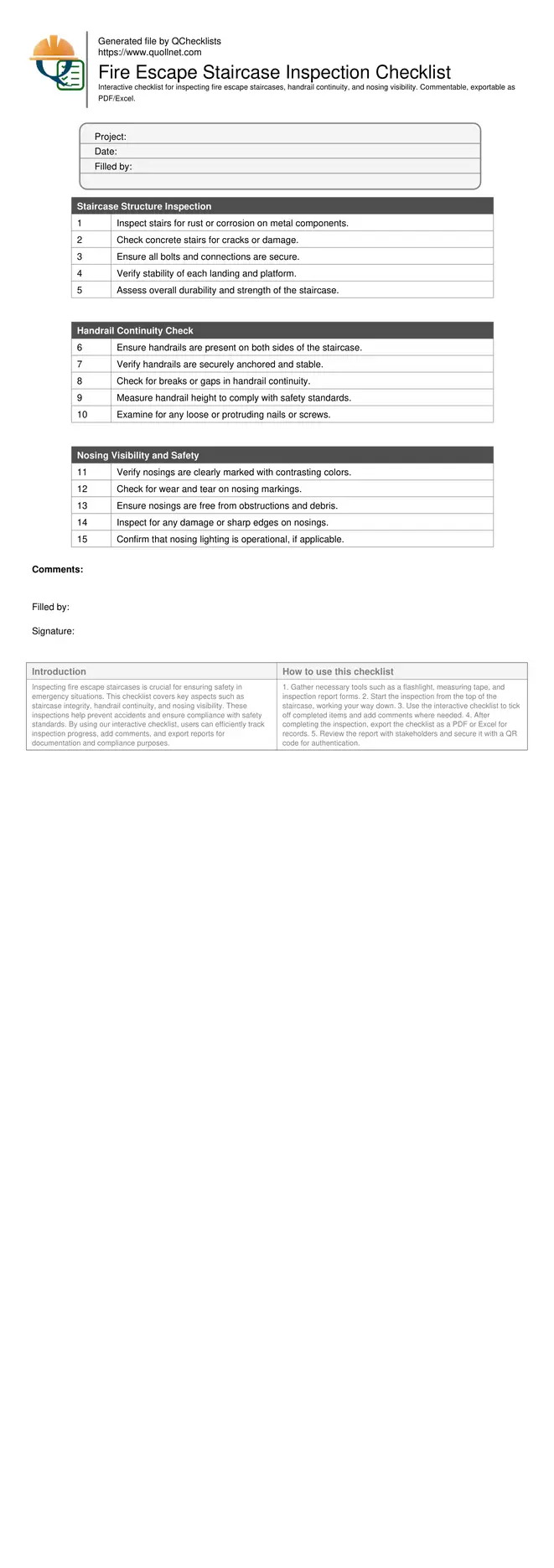Comprehensive Fire Escape Staircase Inspection
Inspecting fire escape staircases is crucial for ensuring safety in emergency situations. This checklist covers key aspects such as staircase integrity, handrail continuity, and nosing visibility. These inspections help prevent accidents and ensure compliance with safety standards. By using our interactive checklist, users can efficiently track inspection progress, add comments, and export reports for documentation and compliance purposes.
- Ensure safety with comprehensive inspection of fire escape staircases, focusing on structure and accessibility.
- Verify handrail continuity to support safe evacuation during emergencies.
- Enhance safety with clear nosing visibility to prevent trips and falls.
- Interactive online checklist with tick, comment, and export features secured by QR code.
Staircase Structure Inspection
Handrail Continuity Check
Nosing Visibility and Safety
Structural Integrity of Staircases
Ensuring the structural integrity of fire escape staircases is a fundamental aspect of safety inspections. This involves checking for any signs of corrosion, damage, or structural weaknesses that could compromise the staircase during an emergency. Regular maintenance and inspections help identify potential issues early.
- Inspect for rust or corrosion on metal components.
- Check for cracks or damage in concrete stairs.
- Ensure all bolts and connections are secure.
- Verify the stability of each landing and platform.
- Assess overall durability and strength of the staircase.
Ensuring Handrail Continuity
Handrails are critical for safe navigation, especially during emergencies. Ensuring handrail continuity helps prevent falls and provides necessary support for individuals using the stairs. Inspections should confirm that handrails are present, properly anchored, and continuous along the staircase.
- Check that handrails are present on both sides of the staircase.
- Ensure handrails are securely anchored and stable.
- Verify there are no breaks or gaps in handrail continuity.
- Measure handrail height to comply with safety standards.
- Examine for any loose or protruding nails or screws.
Nosing Visibility and Safety
Nosing visibility is essential to prevent tripping hazards on staircases. Properly marked nosings enhance visibility, especially in low-light conditions, ensuring safe navigation for all users. Inspectors should ensure that the nosings are clearly visible and in good condition.
- Verify that nosings are clearly marked with contrasting colors.
- Check for wear and tear on nosing markings.
- Ensure nosings are free from obstructions and debris.
- Inspect for any damage or sharp edges on nosings.
- Confirm that nosing lighting is operational, if applicable.
How to Use the Fire Escape Staircase Inspection Checklist
- Gather necessary tools such as a flashlight, measuring tape, and inspection report forms.
- Start the inspection from the top of the staircase, working your way down.
- Use the interactive checklist to tick off completed items and add comments where needed.
- After completing the inspection, export the checklist as a PDF or Excel for records.
- Review the report with stakeholders and secure it with a QR code for authentication.
Call to Action
- Start Checklist Tick off tasks, leave comments on items or the whole form, and export your completed report to PDF or Excel—with a built-in QR code for authenticity.
- Download Excel - Fire Escape Staircase Inspection
- Download PDF - Fire Escape Staircase Inspection
- View Image - Fire Escape Staircase Inspection
